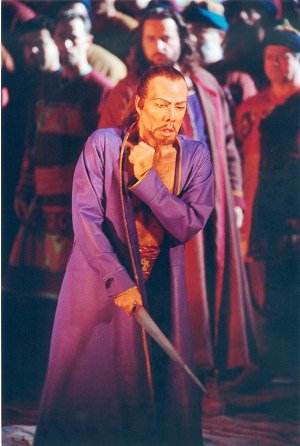This new production of Attila at Opéra Bastille, the first ever for this opera at the Opéra de Paris, was an unqualified failure and there was blame all around. Hughes Gall, the Opéra's General Director, was apparently, like me and uncounted others, smitten in his youth with Jeanne Moreau. After seeing Truffaut's Jules et Jim in late adolescence, I constantly fantasised about showing up at that country house and offering Jeanne a third choice: a too young - but much more ardent - lover. There is hardly another explanation for his choice of her and her theatrical colleague, Josée Dayan to have the task of staging their first ever opera on France's top opera stage during the festivities marking the centenary of the death of Giuseppe Verdi. This indifferently staged and dramatically empty production hobbled the evening from the start.
The conductor this evening, Pinchas Steinberg, delivered a low energy and pedestrian interpretation and throughout it seemed there were parts that needed more rehearsal. Since Verdi had not found his full stride and some musical areas are weak; this slackness is more injurious here than it would be in, for example, La Traviata. All of the characters were sometimes behind the beat - and that beat was sluggish. In the title role, 59 year old Samuel Ramey sounded tired and not as fresh of voice as his Don Quichotte last season in the same house. His sustained notes have a wobble that I had not noticed before. This is a tough role and this could be some of his last performances of it. He still has the ability to make some of the finest sounds any basso can make and was the only credible character actor in the cast.
Carlo Guelfi is one of the fine Verdi baritones singing today and I was impressed with his Rigoletto at the festival at Orange this summer. He helped to make this evening somewhat interesting by his finely tuned and strong Ezio for his debut on this stage. But his portrayal suffered, like the other performers, from the disinterested staging that provided no dramatic pulse to the opera. It seemed like the only concept in operation here was to stage a "retro-production"; something reminiscent of how operas must have been staged in earlier times. The singers, when it was time to sing, walked centre stage, close to the prompter's box, and sang their arias with antique gestures (hand over heart, arms outstretched at the forte passages, etc.) There was no sign of thespian emotion or meaning in almost any of the characters' actions. Usually the stage was empty during solos or duets, and if the dramatic action required a chorus, it was positioned on the side and instructed to stand still. The point guy in the choir had his hands folded over his chest and looked like he would have rather been anywhere else, as did many in the audience.
It was uncomfortable to listen to Franco Farina, the Foresto, which is always a bigger role than you remembered when the singer is not good. The audience greeted his pinched, dry-as-the-Gobi-desert tenor with silence. It was also uncomfortable to listen to Maria Guieghina as Odabella. Guieghina's platinum voice was easily heard throughout the house but, having less and less control of her soprano voice, you were never sure whether she would make her high notes - which she still managed a good part of the time. But the unnecessary shouting, histrionics and poor intonation left the listener on edge whenever she was singing. She apparently was told to stride about the stage like a man, even during the love scenes, and sing with her legs planted apart and always facing the audience. Lacklustre performances were also turned in by Mihajlo Arsenski as Uldino and Igor Matioukhine as Leone.
The stage design was supposed to represent an eroded hill but looked more like zebra stripes painted on the floor. The back of the stage was empty except for projected images of forests or deserts that were as unimaginative and low-tech as a grade-school drama. The costumes had no central theme and seemed like early Hollywood impressions of Tartar garb for the choir. Ramey had packed his ponytail but not his shirt (quelle surprise!) and seemed to be wearing various colourful capes that reminded this viewer of those worn by Yul Brynner in The King and I.
There is a live broadcast of the September 29 performance on France Musiques at 7:30 CET. Six cameras were in the hall recording this evening for posterity. It is hard to imagine why.
Frank Cadenhead
The photo is of the Bass Samuel Ramey. Photo Credit: Eric Mahoudeau

 Return to:
Return to: